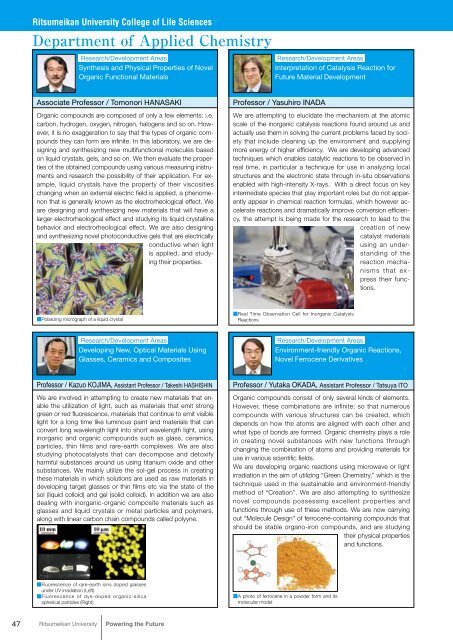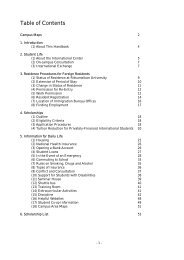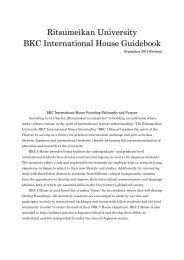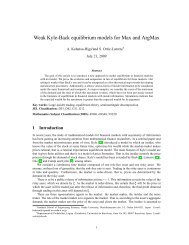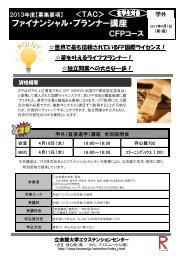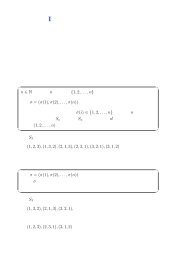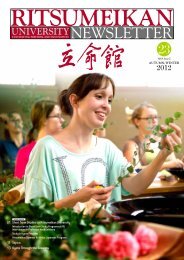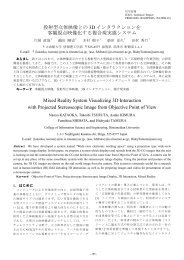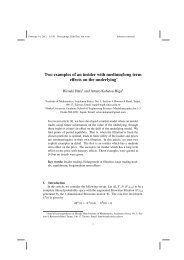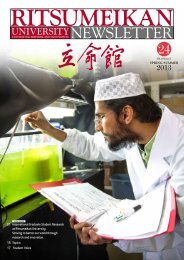Powering the Future - 立命館大学
Powering the Future - 立命館大学
Powering the Future - 立命館大学
Create successful ePaper yourself
Turn your PDF publications into a flip-book with our unique Google optimized e-Paper software.
Ritsumeikan University College of Life Sciences<br />
Department of Applied Chemistry<br />
Research/Development Areas<br />
Syn<strong>the</strong>sis and Physical Properties of Novel<br />
Organic Functional Materials<br />
Research/Development Areas<br />
Interpretation of Catalysis Reaction for<br />
<strong>Future</strong> Material Development<br />
Associate Professor / Tomonori HANASAKI<br />
Organic compounds are composed of only a few elements: i.e.<br />
carbon, hydrogen, oxygen, nitrogen, halogens and so on. However,<br />
it is no exaggeration to say that <strong>the</strong> types of organic compounds<br />
<strong>the</strong>y can form are infinite. In this laboratory, we are designing<br />
and syn<strong>the</strong>sizing new multifunctional molecules based<br />
on liquid crystals, gels, and so on. We <strong>the</strong>n evaluate <strong>the</strong> properties<br />
of <strong>the</strong> obtained compounds using various measuring instruments<br />
and research <strong>the</strong> possibility of <strong>the</strong>ir application. For example,<br />
liquid crystals have <strong>the</strong> property of <strong>the</strong>ir viscosities<br />
changing when an external electric field is applied, a phenomenon<br />
that is generally known as <strong>the</strong> electrorheological effect. We<br />
are designing and syn<strong>the</strong>sizing new materials that will have a<br />
larger electrorheological effect and studying its liquid crystalline<br />
behavior and electrorheological effect. We are also designing<br />
and syn<strong>the</strong>sizing novel photoconductive gels that are electrically<br />
conductive when light<br />
is applied, and studying<br />
<strong>the</strong>ir properties.<br />
Professor / Yasuhiro INADA<br />
We are attempting to elucidate <strong>the</strong> mechanism at <strong>the</strong> atomic<br />
scale of <strong>the</strong> inorganic catalysis reactions found around us and<br />
actually use <strong>the</strong>m in solving <strong>the</strong> current problems faced by society<br />
that include cleaning up <strong>the</strong> environment and supplying<br />
more energy of higher efficiency. We are developing advanced<br />
techniques which enables catalytic reactions to be observed in<br />
real time, in particular a technique for use in analyzing local<br />
structures and <strong>the</strong> electronic state through in-situ observations<br />
enabled with high-intensity X-rays. With a direct focus on key<br />
intermediate species that play important roles but do not apparently<br />
appear in chemical reaction formulas, which however accelerate<br />
reactions and dramatically improve conversion efficiency,<br />
<strong>the</strong> attempt is being made for <strong>the</strong> research to lead to <strong>the</strong><br />
creation of new<br />
catalyst materials<br />
using an understanding<br />
of <strong>the</strong><br />
reaction mechanisms<br />
that express<br />
<strong>the</strong>ir functions.<br />
■Polarizing micrograph of a liquid crystal<br />
■Real Time Observation Cell for Inorganic Catalysis<br />
Reactions<br />
Research/Development Areas<br />
Developing New, Optical Materials Using<br />
Glasses, Ceramics and Composites<br />
Research/Development Areas<br />
Environment-friendly Organic Reactions,<br />
Novel Ferrocene Derivatives<br />
Professor / Kazuo KOJIMA, Assistant Professor / Takeshi HASHISHIN<br />
We are involved in attempting to create new materials that enable<br />
<strong>the</strong> utilization of light, such as materials that emit strong<br />
green or red fluorescence, materials that continue to emit visible<br />
light for a long time like luminous paint and materials that can<br />
convert long wavelength light into short wavelength light, using<br />
inorganic and organic compounds such as glass, ceramics,<br />
particles, thin films and rare-earth complexes. We are also<br />
studying photocatalysts that can decompose and detoxify<br />
harmful substances around us using titanium oxide and o<strong>the</strong>r<br />
substances. We mainly utilize <strong>the</strong> sol-gel process in creating<br />
<strong>the</strong>se materials in which solutions are used as raw materials in<br />
developing target glasses or thin films etc via <strong>the</strong> state of <strong>the</strong><br />
sol (liquid colloid) and gel (solid colloid). In addition we are also<br />
dealing with inorganic-organic composite materials such as<br />
glasses and liquid crystals or metal particles and polymers,<br />
along with linear carbon chain compounds called polyyne.<br />
Professor / Yutaka OKADA, Assistant Professor / Tatsuya ITO<br />
Organic compounds consist of only several kinds of elements.<br />
However, <strong>the</strong>se combinations are infinite; so that numerous<br />
compounds with various structures can be created, which<br />
depends on how <strong>the</strong> atoms are aligned with each o<strong>the</strong>r and<br />
what type of bonds are formed. Organic chemistry plays a role<br />
in creating novel substances with new functions through<br />
changing <strong>the</strong> combination of atoms and providing materials for<br />
use in various scientific fields.<br />
We are developing organic reactions using microwave or light<br />
irradiation in <strong>the</strong> aim of utilizing “Green Chemistry,” which is <strong>the</strong><br />
technique used in <strong>the</strong> sustainable and environment-friendly<br />
method of “Creation”. We are also attempting to syn<strong>the</strong>size<br />
novel compounds possessing excellent properties and<br />
functions through use of <strong>the</strong>se methods. We are now carrying<br />
out “Molecule Design” of ferrocene-containing compounds that<br />
should be stable organo-iron compounds, and are studying<br />
<strong>the</strong>ir physical properties<br />
and functions.<br />
■Fluorescence of rare-earth ions doped glasses<br />
under UV irradiation (Left)<br />
■Fluorescence of dye-doped organic-silica<br />
spherical particles (Right)<br />
■A photo of ferrocene in a powder form and its<br />
molecular model<br />
47 Ritsumeikan University <strong>Powering</strong> <strong>the</strong> <strong>Future</strong>


